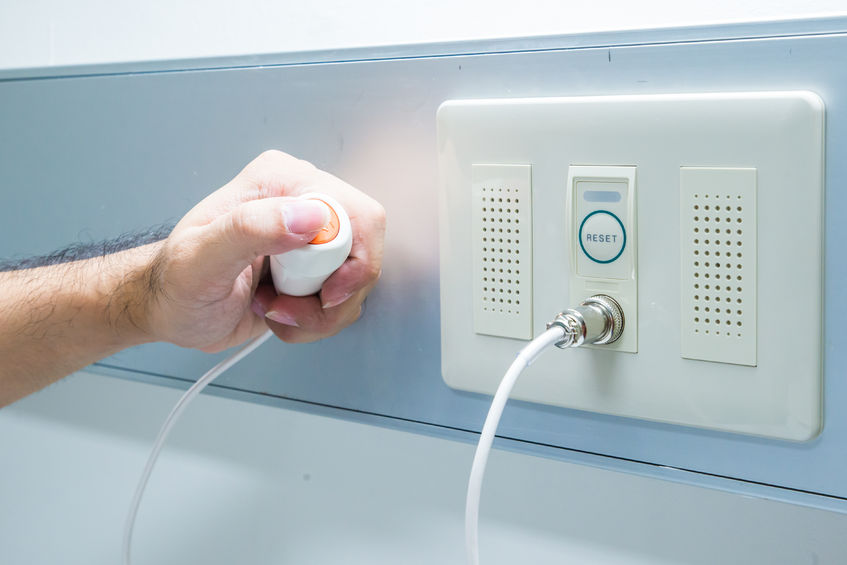Guest Author: Wullie Scott
All healthcare facilities as part of the hospital design process require some kind of Nurse Call System which includes patient-to-staff and staff-to-staff calls when the need arises.
When the nurse call is initiated, it buzzes at the nearest staff base, where the staff responsible can find out from the nurse call panel mounted on the wall, where the call originated. Once in the correct location, they can spot the nurse call lamp which can be ceiling or above door wall mounted to guide the staff to the correct room, where they can use the reset button to reset the buzzers and blinking lights and attend to the patients needs.
A Nurse Call system can be basic that handles patient and emergency calls by use of a button to initiate the call, a lamp that lights to show the staff where the call originated from and a buzzer.
At the opposite end of the scale, these systems can be extremely complicated depending on the requirements of the client and the department it is being used in. Many modern Nurse Call systems are based on Lon Works networks or an I.P. addressable system and offer not only the basic functionality, but the capability of staff presence; cardiac call and bedside communications from the staff base to the patient.
Planning the system
Consideration should be given to the size of the nursing zones and the relationship between staff bases / main corridors / reception desks / clean and dirty utilities with regards to where the calls will originate and where the staff may be (during the day and during night when there is low number of staff monitoring a larger area).
The layout and operation of the system for items like follow me lights / group call should be defined from a principle staff base and subsequently satellite staff bases.
Large nursing zones such as Ambulatory Care, Acute Assessment (Clinical Decision Unit), Accident and Emergency, Outpatient and Imaging, whilst intricate and complex with many sub areas, do require more thought than, say, a general ward. The specialist Nurse Call contractor should work with end users to understand how these departments operate and develop a Nurse call Operational Philosophy Document (NCOPD). This will detail not just zones but the intended operation of the system.
Design Architectural Input
The basic design of a Nurse call system is relatively simple however the equipment almost always seems to cause confusion amongst architects, clinical planners and hospital staff. It should be recognized that it is made of different components and consideration on descriptions of the various component parts should be carefully considered.
You will expect tocome across the following items and descriptions;
Patient call
Various descriptions for this item: Patient call handset or call pull cord or call handset or call handset with integrated light controls
Patient call description may also include the following descriptors added;
Reset button / Reset button with integrated patient reassurance light / Staff emergency call
It should be noted the description should clearly define the function of the unit as a composite item. As using separated item codes cause confusion and clients and validation teams often end up looking for individual items.
Commissioning of the system
Thought should also be given to the priority of call and how it should be presented to the staff. For example, a staff-to-staff call for Crash Call (to resuscitate a patient with cardiac arrest) would take priority over a normal patient-to-staff call for a glass of water or pain killers.
LCD panel should be mounted at the Staff bases and if required, at strategic points within the area served by each system such as Staff rest rooms and Corridors.
A patient call should display on the appropriate indicator panels displaying the source of the call providing audio and visual indication of an active call. Clean and Dirty utilities should have as a bare minimum lamp buzzer units fitted so if the staff are working there, they can be alerted. Other staff areas should also be considered i.e. Pantries, Drug prep, Staff offices and corridors. These should be defined in the NCOPD as functions.
Over door indicators generally illuminate the source of the call outside the room and in multibed areas above the patient bed.
The type of call generated will define the priority of a call i.e., the lowest to the highest are defined as follows:
Low: Patient call
Medium: Bathroom / Toilet call
High: Emergency
Highest: Cardiac arrest call
Consideration should be given to the above the door indication when a call is active and are generally overridden by extinguishing the light outside the room when the system receives a higher priority call returning to the previous state when the higher priority call has been reset. In multi bed areas the lower priority call should remain on to reassure a patient that their call has not been cancelled.
About the author
Wullie Scott is a Hospital Nurse Call Systems Specialist. He has many years of practical design & implementation level experience on large hospitals in the UK and abroad. You can benefit from his experience at hospitaldesigntips.com. If you have current or upcoming projects big or small or topics that you would like his advice on, you can get in touch via the contact us form.

